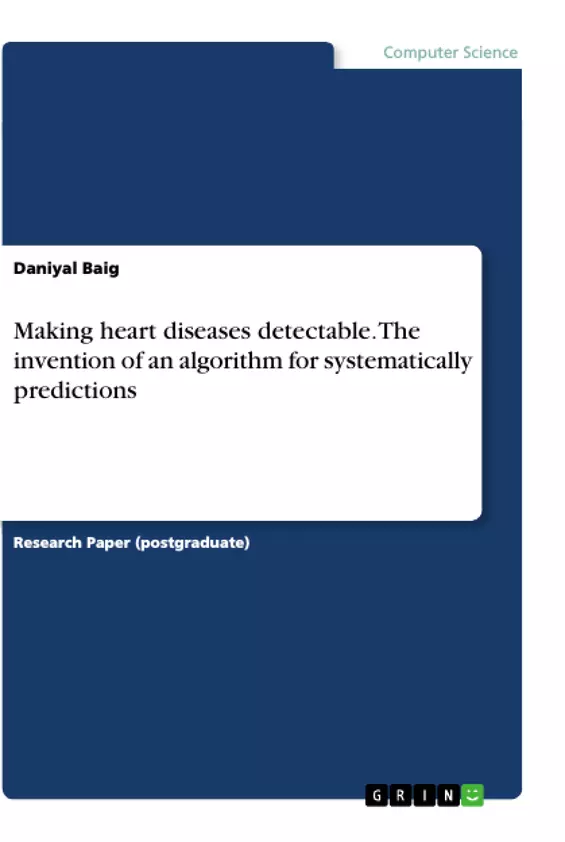In this research paper it will be conducted and experimentally analysed to seek an improved method to predict heart disease in the upcoming years. So efficient steps can be taken in order to predict and treat the avoidable fatal heart problem. This work will be creating an efficient algorithm which will detect the disease on the basis of some parameters and give as much accurate information as possible. By using this method one can systematically predict the risk of suffering from this disease. The main feature utilized in the detection will include age, gender, max heart rate, exercise induced angina etc.
In today’s world the heart disease is increasing. Hence a lot of data related to the heart disease is being collected by using data mining. This important can be evaluated and used to predict and detect the coronary artery disease and heart related problem before the occurrence of the fatal experience. Many different types of life threating diseases are amongst people but heart disease has been studied the most in medical research. Early diagnosis of the disease is a very difficult task. We want to introduce an automated way of prediction of heart disease in individuals. This solution is not one and all solution but it will serve as a complementary diagnosis in the field of medical research. The main task in heart disease is to detect the disease early and treat it efficiently before any fatal experience occurs.
Inhaltsverzeichnis (Table of Contents)
- Abstract
- Introduction
- Heart disease
- Literature review
- Proposed Algorithm
- Classification
- Data set
- Heart UCI Dataset
- Used Prediction models
- Naive Bayes
- K nearest neighbor
- Decision tree
- Random forest
- Experimentation Results
- Conclusion
- References
Zielsetzung und Themenschwerpunkte (Objectives and Key Themes)
This research paper aims to develop an efficient algorithm for predicting heart disease using machine learning techniques. The goal is to create a system that can identify individuals at risk of developing heart disease based on various parameters, potentially leading to early intervention and improved treatment outcomes.
- Application of machine learning for heart disease prediction
- Development of an efficient algorithm for disease detection
- Utilizing data mining techniques to analyze heart disease data
- Identifying key parameters and features for predicting heart disease
- Improving early diagnosis and treatment of heart disease
Zusammenfassung der Kapitel (Chapter Summaries)
- Abstract: This section introduces the increasing prevalence of heart disease and the potential of using data mining to predict and diagnose it. It highlights the goal of developing an improved method for predicting heart disease and emphasizes the need for early detection to prevent fatal outcomes. The main features utilized in the prediction model include age, gender, maximum heart rate, and exercise-induced angina.
- Introduction: The importance of early heart disease diagnosis is discussed, and the need for an automated prediction system is highlighted. The limitations of current diagnostic methods and the rising incidence of heart disease are presented. The paper emphasizes the importance of early detection and the potential benefits of a machine learning-based prediction system.
- Heart disease: This section provides a basic definition of heart disease and its role in the human body. It lists several factors that contribute to an increased risk of heart disease, such as smoking, family history, obesity, high blood pressure, and physical inactivity.
- Literature review: This section discusses the prevalence of heart disorders and the challenges associated with early diagnosis. It mentions various machine learning algorithms that have been used for heart disease classification, including Naïve Bayes, Random Gradient Descents, Support Vector Machine, K-Nearest Neighbor, Adaboost, JRip, and J48.
- Proposed Algorithm: This chapter outlines the algorithm used for predicting heart disease. It describes the classification methods employed, the specific dataset used (Heart UCI Dataset), and the prediction models explored. The models include Naive Bayes, K nearest neighbor, Decision Tree, and Random Forest.
Schlüsselwörter (Keywords)
This research paper focuses on the application of machine learning and data mining techniques for predicting heart disease. Key themes include supervised learning algorithms, heart disease prediction, and the utilization of various machine learning models for diagnosis. The research explores the use of parameters like age, gender, maximum heart rate, and exercise-induced angina to develop an accurate and efficient prediction system.
- Citation du texte
- Daniyal Baig (Auteur), 2020, Making heart diseases detectable. The invention of an algorithm for systematically predictions, Munich, GRIN Verlag, https://www.grin.com/document/953437



